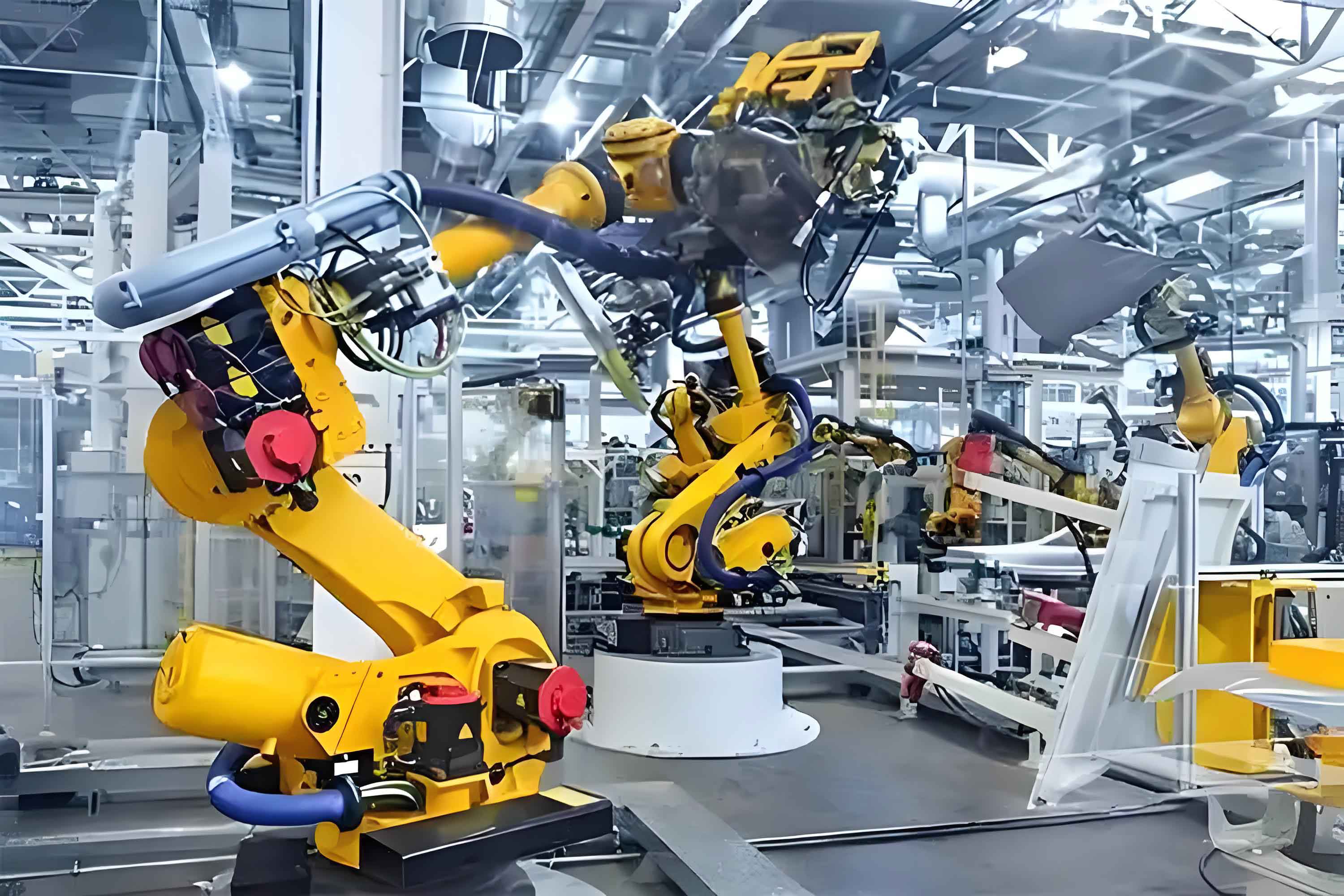1. Introduction
Industrial robots are indispensable in modern manufacturing, particularly for complex tasks like grinding. Achieving precise constant force control during robotic grinding in unknown environments remains challenging due to unpredictable environmental stiffness (KcKc) and position (XeXe). Traditional impedance control methods exhibit significant force overshoot and instability when encountering variable workpiece stiffness. To address this, we propose a novel dual-loop control framework integrating adaptive sliding mode control (inner loop) with environmental parameter estimation and adaptive variable impedance control (outer loop). This approach enables real-time estimation of unknown environmental parameters and dynamic adjustment of impedance parameters, significantly enhancing the adaptability and stability of robotic grinding systems.

2. Methodology
- 2.1 Control Architecture
The proposed framework comprises:- Inner Loop: Adaptive Sliding Mode Control (ASMC) for precise position tracking.
- Outer Loop: Environmental Parameter Estimator (EPE) and Adaptive Variable Impedance Controller (AVIC) for real-time estimation of KcKc, XeXe and impedance parameter adjustment.
Key interactions are governed by:
- 2.2 Adaptive Sliding Mode Control (Inner Loop)
The robot’s end-effector is modeled as a mass-spring-damper system:{X˙1=X2X˙2=um−dmX2−kmX1{X˙1=X2X˙2=mu−mdX2−mkX1where X1=XeX1=Xe (actual position), uu is the control law, mm is mass, dd is damping, and kk is stiffness. The sliding surface ss and adaptive law for coefficient cc are:s=ce+e˙,c˙=re∫s dt+kc0s=ce+e˙,c˙=re∫sdt+kc0with e=Xr−Xee=Xr−Xe (tracking error). The control law uu ensures robustness against disturbances. - 2.3 Environmental Parameter Estimation (Outer Loop)
KcKc and XeXe are estimated in real-time using force (FmFm) and position (XeXe) feedback. Gravity-compensated force FmFm is:Fm=Fc−GcosθFm=Fc−Gcosθwhere FcFc is the measured contact force and GG is end-effector gravity. Estimation rules derived via Lyapunov stability are:K^˙c=−ξ1Xe(F^c−Fm)X^˙c=1K^c(ξ1XeX^c+ξ2(F^c−Fm))F^c=K^c(Xe−X^c)K^˙cX^˙cF^c=−ξ1Xe(F^c−Fm)=K^c1(ξ1XeX^c+ξ2(F^c−Fm))=K^c(Xe−X^c)This enables generation of the desired position Xd=FdK^c+X^cXd=K^cFd+X^c. - 2.4 Adaptive Variable Impedance Control (Outer Loop)
Combines impedance control with Model Reference Adaptive Control (MRAC). The position compensation δxδx is:δx=g(t)+p(t)ef(t)+d(t)e˙f(t)δx=g(t)+p(t)ef(t)+d(t)e˙f(t)where ef=Fd−F^cef=Fd−F^c (force error). Adaptive laws for g(t)g(t), p(t)p(t), and d(t)d(t) ensure stability:g(t)=g0−μ1∫0tχ dt−σ1∫0tg(t) dtp(t)=p0−μ2∫0tχef(t) dt−σ2∫0tp(t) dtd(t)=d0−μ3∫0tχX˙e dt−σ3∫0td(t) dtg(t)p(t)d(t)=g0−μ1∫0tχdt−σ1∫0tg(t)dt=p0−μ2∫0tχef(t)dt−σ2∫0tp(t)dt=d0−μ3∫0tχX˙edt−σ3∫0td(t)dtwith χ=−λpef(t)+λsX˙eχ=−λpef(t)+λsX˙e. This indirectly tunes impedance parameters for adaptive robot behavior.
3. Simulation Experiments
- 3.1 Setup
Co-simulation using Adams (robot grinding virtual prototype) and Matlab/Simulink (control system). Parameters:Md=0.8,Bd=100,Kd=100;ε=10.8,h=12.2,re=0.2,kc0=3.5;ξ1=0.4,ξ2=0.78;λp=0.5,λs=0.1,μ1,2,3={2.1,1.2,2},σ1,2,3={2,0.8,1.4}.Md=0.8,Bd=100,Kd=100;ε=10.8,h=12.2,re=0.2,kc0=3.5;ξ1=0.4,ξ2=0.78;λp=0.5,λs=0.1,μ1,2,3={2.1,1.2,2},σ1,2,3={2,0.8,1.4}.Workpiece stiffness: 100,000–200,000 N/mm. - 3.2 Results
Table 1: Force tracking performance under constant expected forces (simulation).Expected Force (N)Stiffness (N/mm)MethodOvershoot (σF%σF%)Fluctuation (FbFb/N)Rise Time trtr (s)Settling Time tsts (s)20150,000Fuzzy Impedance14.81±2.740.220.6620150,000Proposed0±1.461.211.2730200,000Fuzzy Impedance14.81±2.740.220.6630200,000Proposed3.93±1.890.131.09*Table 2: Dynamic force tracking (simulation, stiffness = 150,000 N/mm).*Force ProfileMethodAvg. Error EfEf (N)Fluctuation FbFb (N)Overshoot (σF%σF%)Ramp (Descending)Fuzzy Impedance0.08±1.987.93Ramp (Descending)Proposed0.05±1.870Step (Descending)Fuzzy Impedance0.18±2.067.93Step (Descending)Proposed0.13±1.870SinusoidalFuzzy Impedance0.16±1.987.93SinusoidalProposed0.15±1.640Key Findings:- The proposed method eliminated or minimized force overshoot (0–3.93% vs. 7.93–14.81% for fuzzy impedance).
- Force fluctuations reduced by 31.02–46.25% across stiffness variations.
- Consistent tracking for dynamic profiles (ramp, step, sinusoidal) validated adaptability.
4. Robotic Platform Experiments
- 4.1 Setup
- Robot: 6-DOF wrist-offset abrasive robot (repeatability ±0.05 mm, payload 70 kg).
- End-Effector: 2R1T force-controlled parallel mechanism (±12°×±12°×25 mm workspace).
- Workpieces: Aluminum plate (Kc≈Kc≈ 100,000 N/mm) and iron plate (Kc≈Kc≈ 200,000 N/mm).
- Controller: Beckhoff CX-260354 with EtherCAT communication.
- 4.2 Results
Table 3: Force tracking performance (experimental).WorkpieceExpected Force (N)MethodOvershoot (σF%σF%)Fluctuation FbFb (N)Surface Roughness RaRa (μm)Aluminum20Fuzzy Impedance11.0±2.991.044Aluminum20Proposed0±2.130.903Iron30Fuzzy Impedance30.63±7.801.451Iron30Proposed4.67±3.420.999Aluminum40Fuzzy Impedance20.22±5.231.367Aluminum40Proposed10.75±4.101.217Iron40Fuzzy Impedance41.25±8.991.751Iron40Proposed18.50±6.871.392Table 4: Performance improvement summary.MetricImprovement vs. Fuzzy ImpedanceForce Overshoot (σFσF)11.0–25.96% reductionForce Fluctuation (FbFb)28.76–56.15% reductionSurface Roughness (RaRa)10.97–31.15% reductionKey Findings:- Force overshoot reduced by 9.47–25.96% across workpieces and forces.
- Force fluctuations reduced by 28.76–56.15%.
- Surface roughness improved by 10.97–31.15%, demonstrating higher grinding quality.
5. Discussion
The dual-loop adaptive framework enables the robot to estimate and compensate for unknown environmental dynamics in real-time. While the proposed method increases rise/settling times by 15–40% compared to fuzzy impedance, it eliminates catastrophic force overshoot—critical for precision grinding. The integration of ASMC, EPE, and AVIC ensures:
- Robust Position Tracking: ASMC maintains < 0.0004 mm position error under dynamic forces.
- Environmental Adaptability: EPE achieves accurate KcKc/XeXe estimation without prior knowledge.
- Stable Force Control: AVIC reduces force fluctuations by >30% under variable stiffness.
Future work will focus on optimizing transient response and integrating posture-force coordination.
6. Conclusion
We present an adaptive variable impedance control strategy for robotic grinding in unknown environments. The method synergizes adaptive sliding mode control (inner loop) with environmental parameter estimation and model-reference adaptive impedance control (outer loop). Validated through rigorous simulations and robotic platform experiments, our approach:
- Eliminates force overshoot during contact (0–4.67% vs. 11–41.25% for fuzzy impedance).
- Reduces force fluctuations by 28.76–56.15%.
- Improves surface roughness by 10.97–31.15%.
This framework significantly enhances the adaptability, stability, and precision of industrial robots in unstructured grinding tasks, paving the way for broader deployment in high-value manufacturing.
Appendix: Key Nomenclature
| Symbol | Description | Symbol | Description |
|---|---|---|---|
| XeXe | Actual position | FdFd | Desired grinding force |
| XrXr | Reference position | FmFm | Measured grinding force |
| XdXd | Desired position | KcKc | Environmental stiffness |
| δxδx | Position compensation | XeXe | Environmental position |
| Md,Bd,KdMd,Bd,Kd | Impedance parameters | K^c,X^eK^c,X^e | Estimated parameters |
| efef | Force error | σFσF | Force overshoot |
| FbFb | Force fluctuation | RaRa | Surface roughness |
